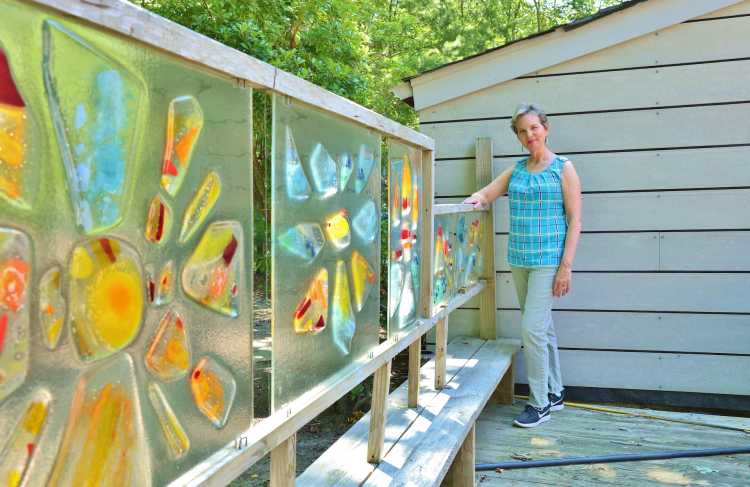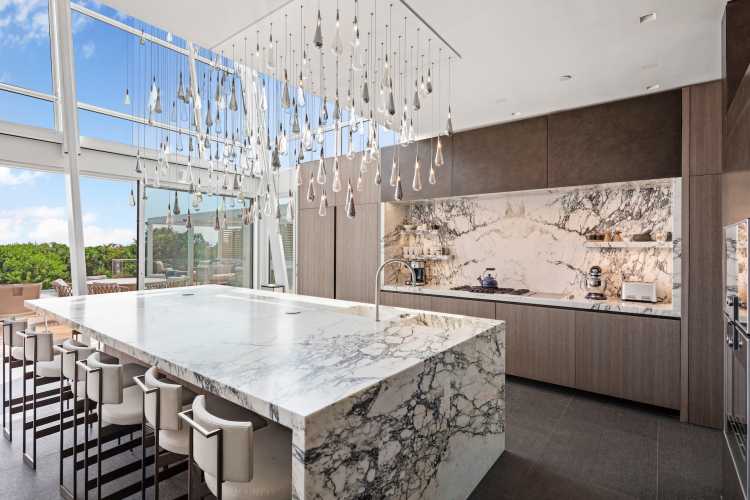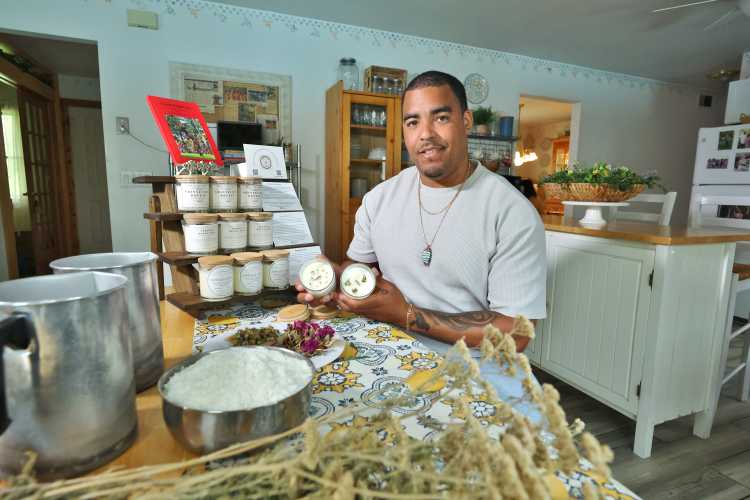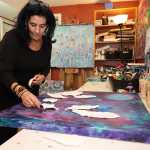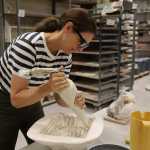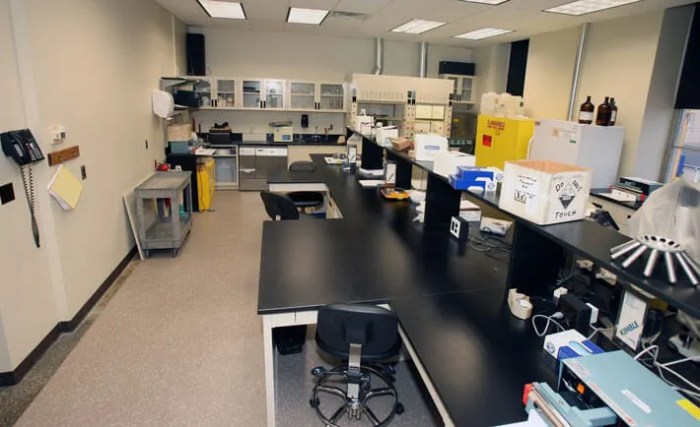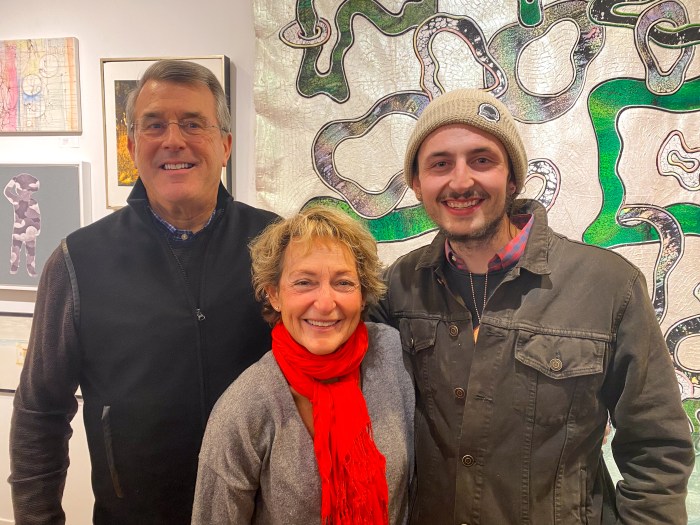Most people collect seashells and sea glass from the beach and aren’t sure what to do with them, so they end up either back on the shore or in a jar sitting in the house — a seemingly aesthetic home accessory that is really missing the next step. But, Hayley Di Rico isn’t most people.
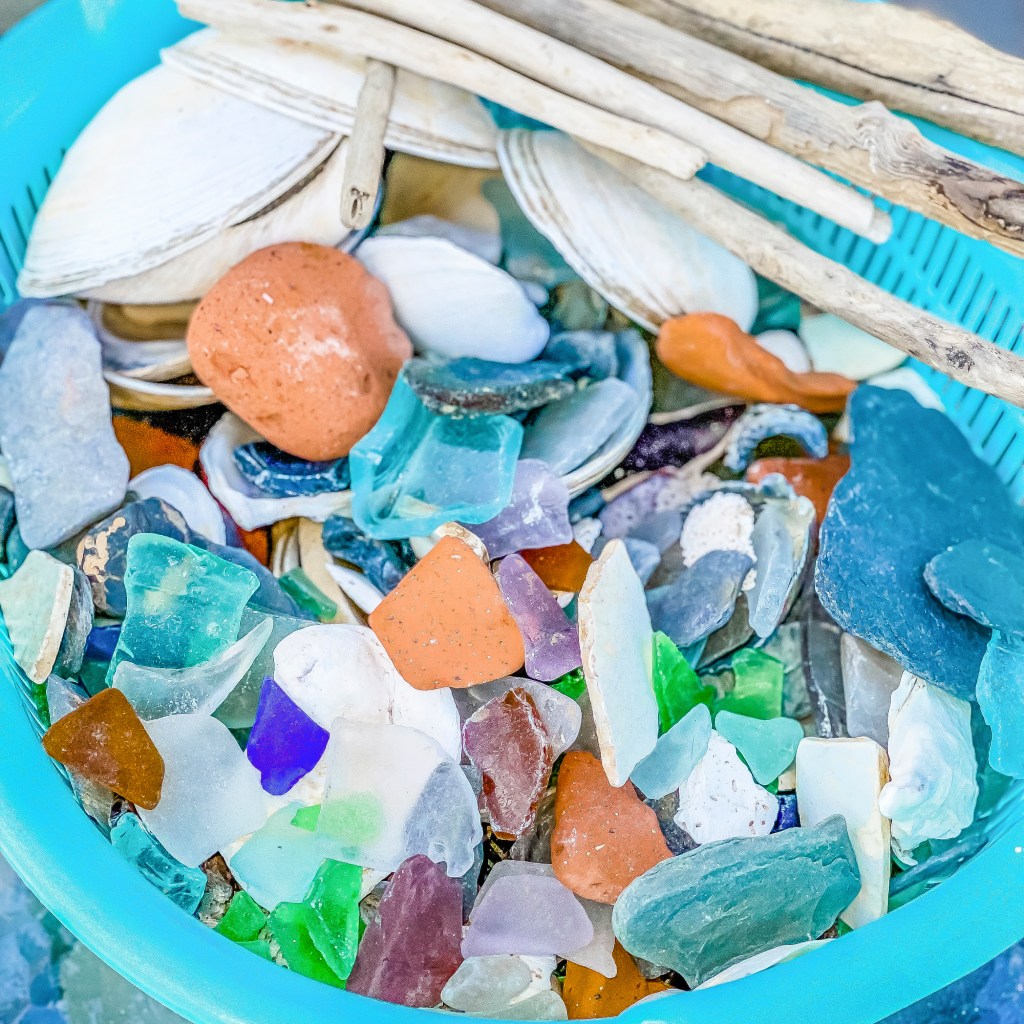
While she began as most people do, collecting items from the beach, it wasn’t long before her husband told her, “You can’t bring home any more sea glass. There’s no more jars in the house. What are you going to do with this?” she recalls.
A lover of mixed media with a background in graphic design and art, Di Rico delved into crafting home accessories from her beach finds. She paints nature scenes and uses watercolor to bring in color and texture. She also prides herself on using many different materials — sea glass, moss, coral, shells, driftwood — all to give a real feel of nature.
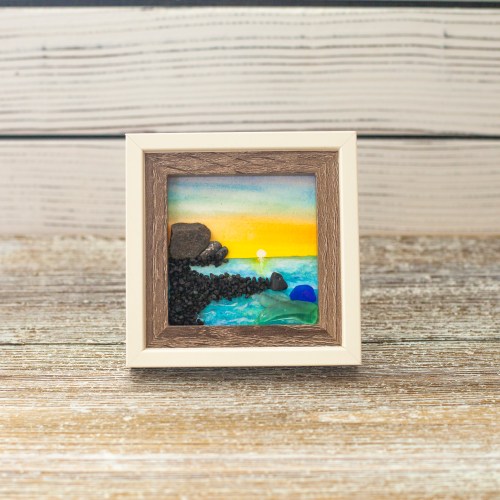
“All of my sea glass, seashells, driftwood, and rocks are handpicked from the beach. Only materials like watercolor paint, paper, moss, tiny dowels, wire and glass bottles are purchased,” she says. Oftentimes, she’ll create a piece based on what she picks up along the shore that day.
“Every piece is unique. Whatever I make today, I will never be able to recreate it exactly tomorrow,” she says.

Having studied graphic design and photography at Baruch College and being a watercolorist, as well as a photographer for the New York Mets, mixed with her youth spent on the beach in Sheepshead Bay and Brighton Beach, she launched her hobby into a full-fledged career.
“The imaginative artwork behind Sea Schleps was inspired by my love of sea glass and the collection I acquired from summer trips to the beach as a young girl,” says Di Rico, who grew up in Brooklyn.
After leaving her work as an art marketing director for two wholesale distributors to pursue freelance opportunities and focus on raising her twins, Ethan and Charlotte, she decided to pick up her watercolor work again to create home accessories like catch-alls by combining hand-picked sea glass, sea pottery, rocks, driftwood and seashells with hand-painted watercolor.
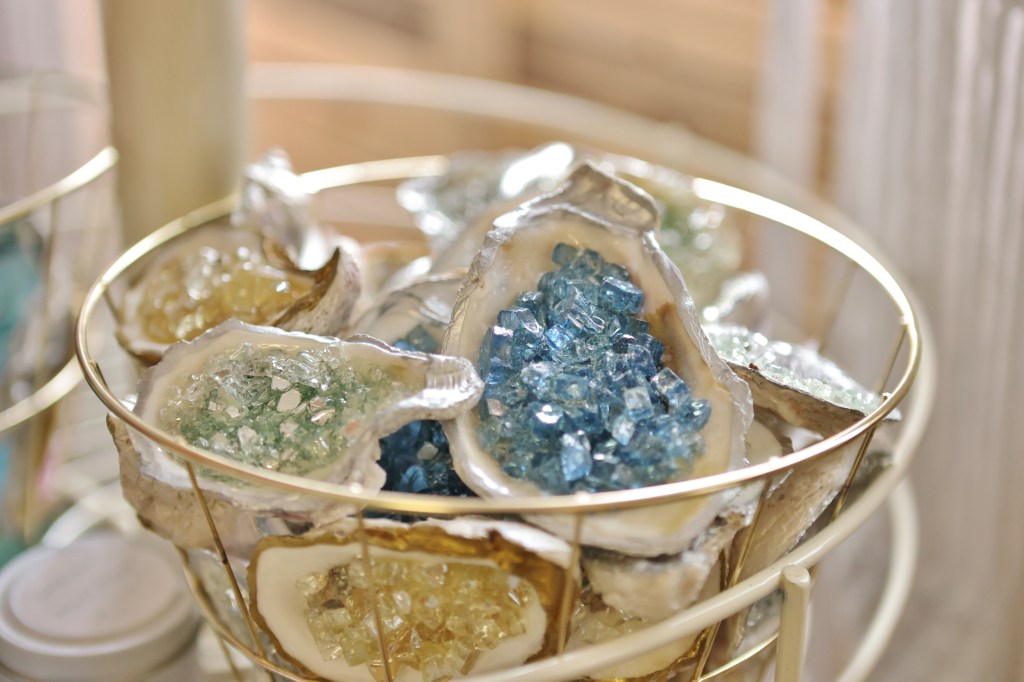
At the beginning, she gave her creations to friends and family, but it wasn’t long before the word spread and people started asking to purchase her designs. “So I started selling it, and then it tumbled into going to pop ups and flea markets and going to street fairs. And the demand became so high that I incorporated and I became a business,” she says. “This is my consistent way of staying creative.”
The Meaning Behind the Name
“Every time I go to the beach and I bring home all the things I found, I’d say, ‘Oh, look at all the things I schlepped back today,’” and thus Sea Schleps was born.
The word “schlep” is a German Yiddish word which means “to drag.” While Di Rico is her married name, she was born to a Jewish family and Yiddish words were commonly used around the home.
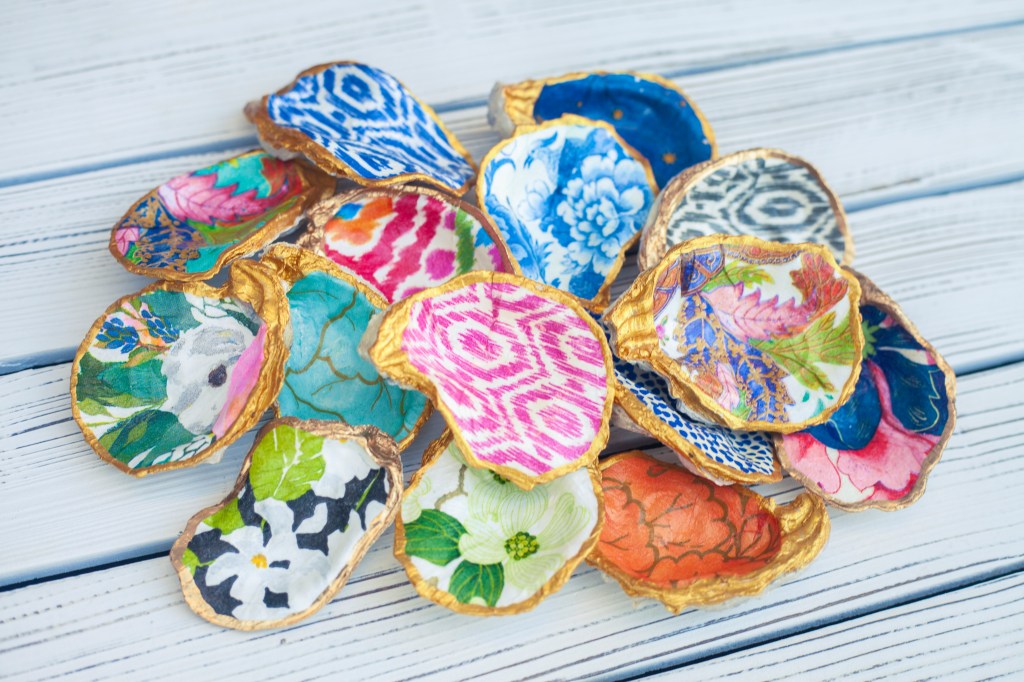
After incorporating her business, Di Rico began selling her work in different stores and at fairs and festivals on Long Island, giving her the ability to network with other artists and business owners to find the best stores and galleries to approach with her artwork. She was also proactive at reaching out to local handmade art stores and galleries in beach communities where her artwork would best fit in with the demand and “coastal/beach vibe” of the area.
“I’ve been able to go to fairs and art shows in different towns, different neighborhoods throughout Long Island, and I’ve met many other sea glass artists… Either they just use their materials and make a mosaic, or they do something very simple, or they make jewelry and things like that,” she says. “No one does quite what I do.”
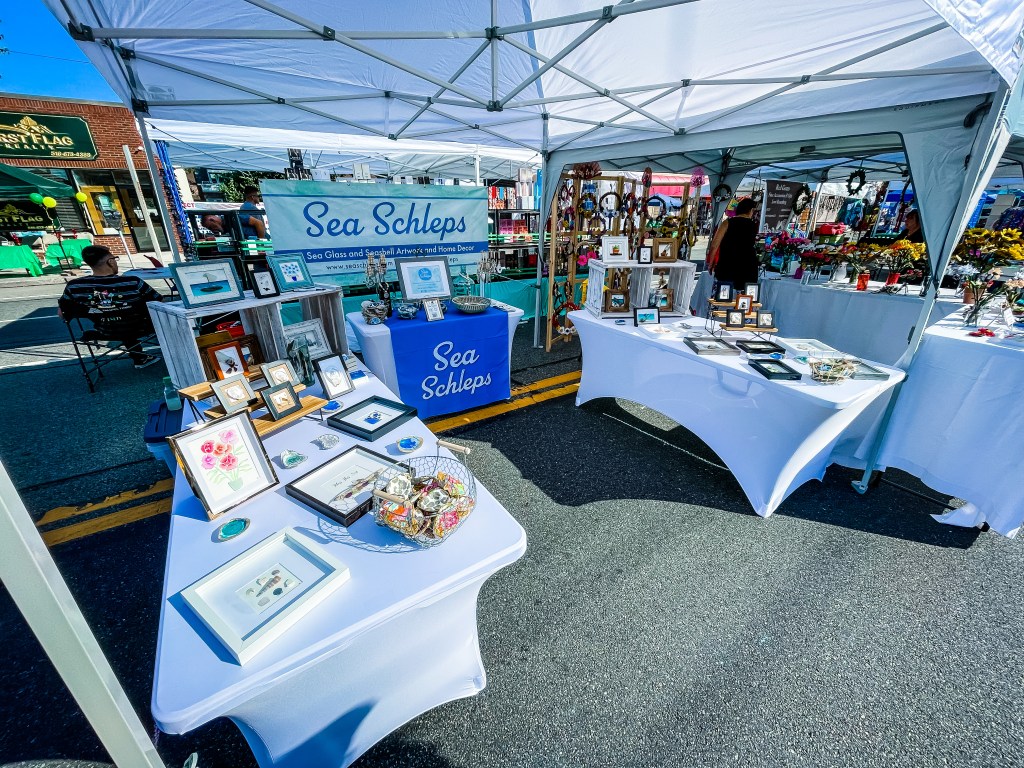
What began in her home expanded into an Oyster Bay studio at The Hive Market and Maker’s Space, a place for artists to work on their craft and sell their pieces in an adjacent market, which Di Rico says has been a very supportive environment for her. “Through the help of owner Laura Escobar, I have received more opportunities to connect with customers through hosting workshops throughout the year, meet other talented vendors and makers, sell my artwork at their store, street fairs and other art festivals that Laura is affiliated with,” she says. “I am currently renovating my house so The Hive has been a second home for my artmaking and creations.”
Drawing Inspiration
“I try to use everything that I pick up from the beach, I try to find a way to become creative with it,” she says. When she began collecting clam shells and oyster shells, she made decoupage patterns inside of the oyster shells to make little ring dishes or hand painted the clam shells to make abstract, colorful patterns for a catch-all dish. Wine bottle charms and oyster garlands are also among her latest creations.
“All of my artwork involved gluing pieces to my canvas to create the scene or subject of the design. For most of my nature scenes, I will hand paint a watercolor background before gluing my material to the canvas. Sometimes, I will tape my hand painted background to a picture frame mat and then glue my materials to the background and overlapping on the mat. This gives an overflowing/third dimensional effect to my creation. Some designs are finalized in a day while others may take several days depending on the complexity of the design,” she says of her process.
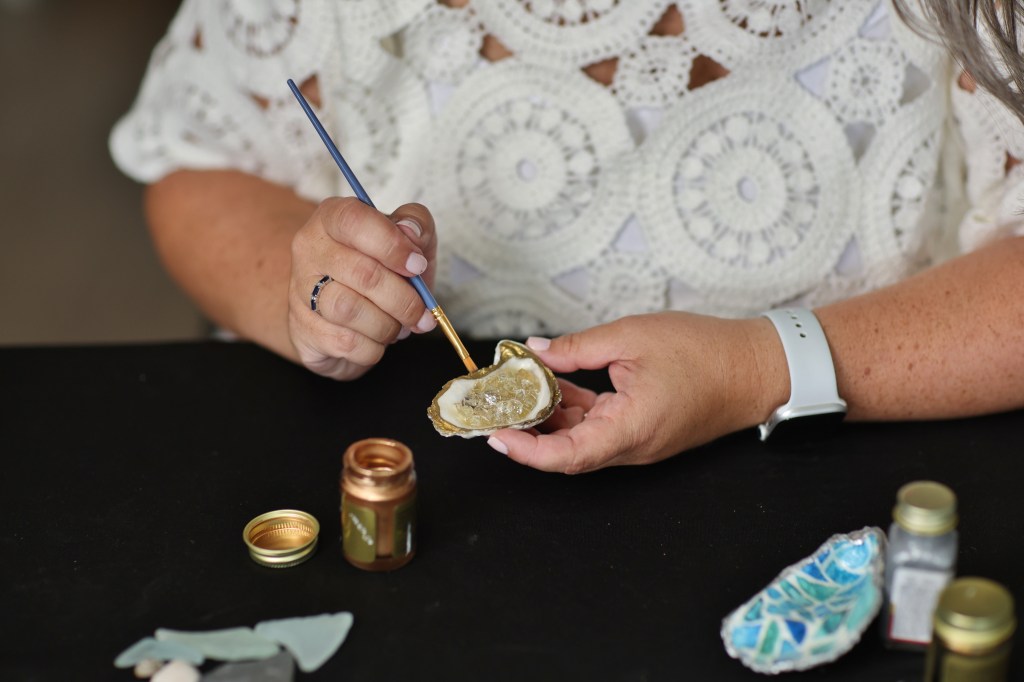
Aside from walking along the shore, she also draws inspiration from elsewhere.
“My children are a big influence in my process,” she says of her nine-year-old twins. “They said, ‘Mom, we really love penguins. Can you make a penguin design?’ — which I didn’t think I could do, and so I painted a penguin, and then I used sea glass to make the wing and the face and it became a huge hit.” It then mushroomed into an entire series on the seabirds.
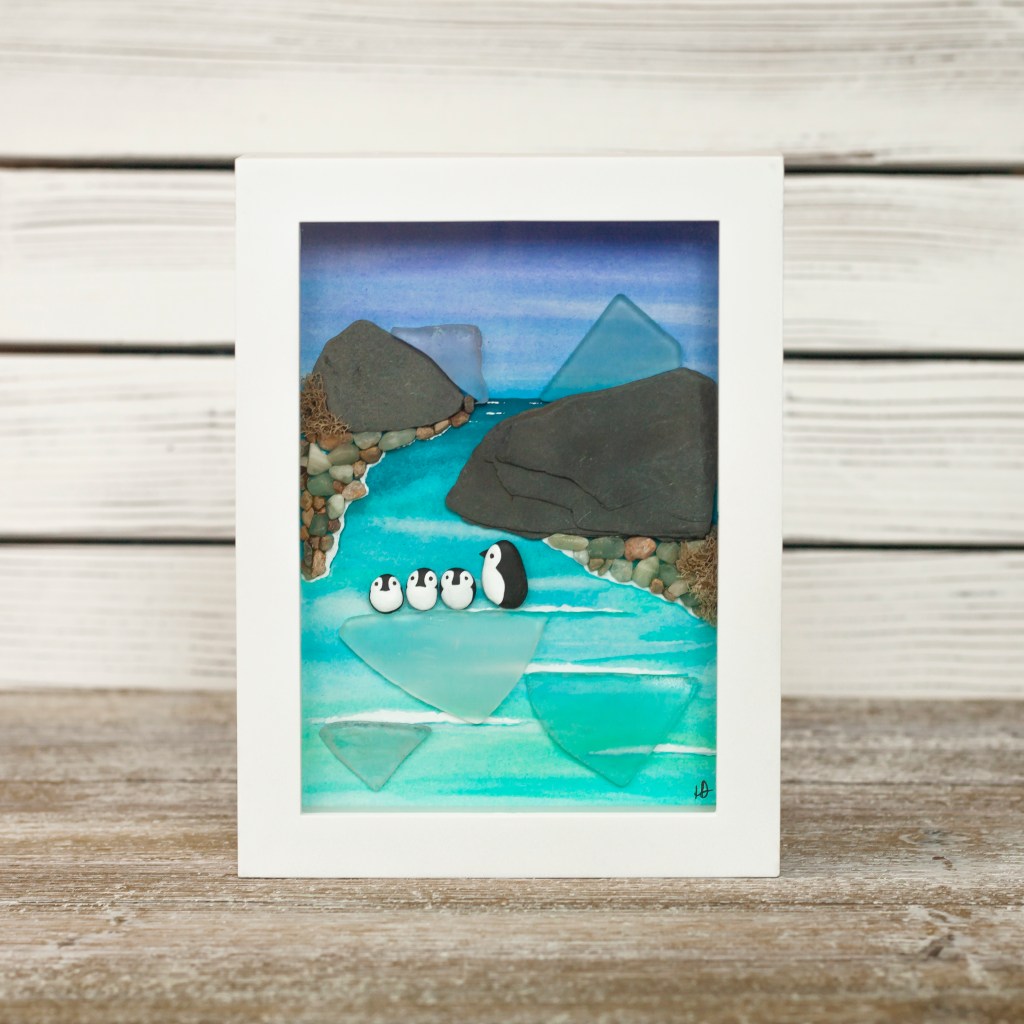
“They will push me with ideas that I won’t think of, that their little imaginations come up with and it helps to stretch my own creativity,” she adds.
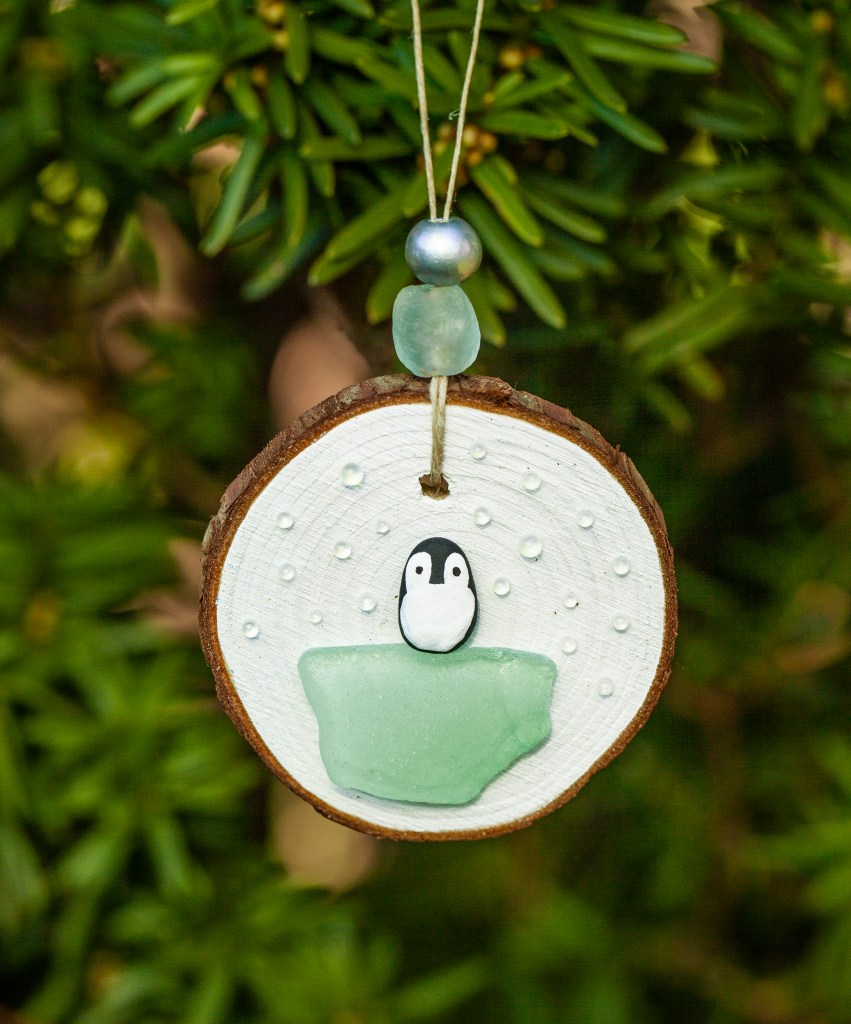
Di Rico brought her work to her children’s classroom when she led a workshop at their school in June with about 80 students. She showed them her work as an instructor for beachcombing art and taught them her process.
She offers similar workshops at The Hive for smaller groups interested in learning her craft.
Di Rico also did a collaboration, Sunrise Pottery LI x Sea Schleps, with a local potter and ceramic artist she met at the Garden Farmers Market in Patchogue who shares love for sea glass. Di Rico’s sea glass was melted and fused into her pieces to make crackled patterns in capsule dishes, coastal themed catch-all and ring dishes. The collaboration was a huge hit according to Di Rico. “It was a really beautiful collaboration. I’m so glad I had an opportunity to do that,” she says.
‘Overlooked’ Pieces
Di Rico shares that she doesn’t tend to search for the most smooth or round pieces of sea glass. Rather, she reaches for the broken pieces that are a bit rough around the edges.
“It has to have something unique about the shape for me to be able to turn it into something. So usually I pick up things that people overlook,” she says. “I like the things that really are different, that are broken in a very unique one of a kind way.”
She also says that she looks for unique colors. On Long Island, lavender and cobalt blue pieces are common. Uranium glass can be found too, considered a rare and valuable find, given that it was used for bombs and nuclear power reactors and was banned during World War II and the Cold War. Many manufacturers used to use uranium in glassware because it would make it green and glow, Di Rico shares. Such a small amount of uranium was used that the amount of radioactivity is not considered harmful. These ultraviolet pieces that wash up on the shore tend to be bright green “Vaseline glass” or pale-yellowish green or even white, but the real indicator is darkening the room, shining a UV light on the piece and seeing if it glows.
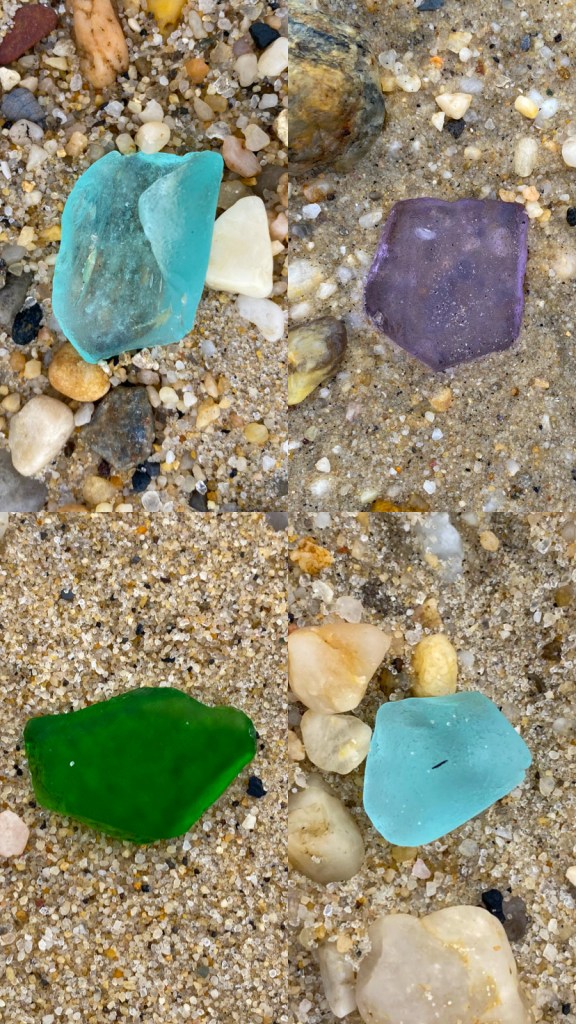
“We are able to find a lot of these pieces along the North Shore because of its rich and long history dating back from the colonial period as well as even older items from the Indigenous native people of Long Island,” she says. “Unfortunately — or not for sea glass and sea pottery enthusiasts — waste from the mid 1600s to early 1900s was dumped in our waterways. All organic matter broke down, but all the glass and ceramic items survived. These items are rare to find due to other collectors picking up the pieces and because plastic is more commonly used than glass and pottery now.”
“People would just dump their things into the ocean. And now after decades and decades of charting in the water, they come up on the shoreline,” she says. “I love finding pottery because sometimes, depending on the pattern that’s printed on it, you can actually date when that piece was made.” Most of these items can be dated and give context to local history.
When Di Rico finds these historical pieces, she says, “I feel like I’m connected to the history of my home.”
The overlooked pieces as well as those full of history have proven successful, with returning customers filled with raving reviews. While she never knows how her work will be used, or whether her customers plan to gift or keep the pieces they purchase, they’ll often send her a picture of it in their home. “It’s nice to know where your art ends up,” she says, like a baby penguin in a nursery for a baby, “which is so beautiful to know.”
Staying True to Yourself
Making these pieces for clients and their homes as they go through life’s monumental moments has been extremely impactful for Di Rico, giving her a feeling of purpose.“I always felt like there was something missing, that there was a bigger purpose,” she says. “Finding a way to be creative for myself was really like the biggest gift.”
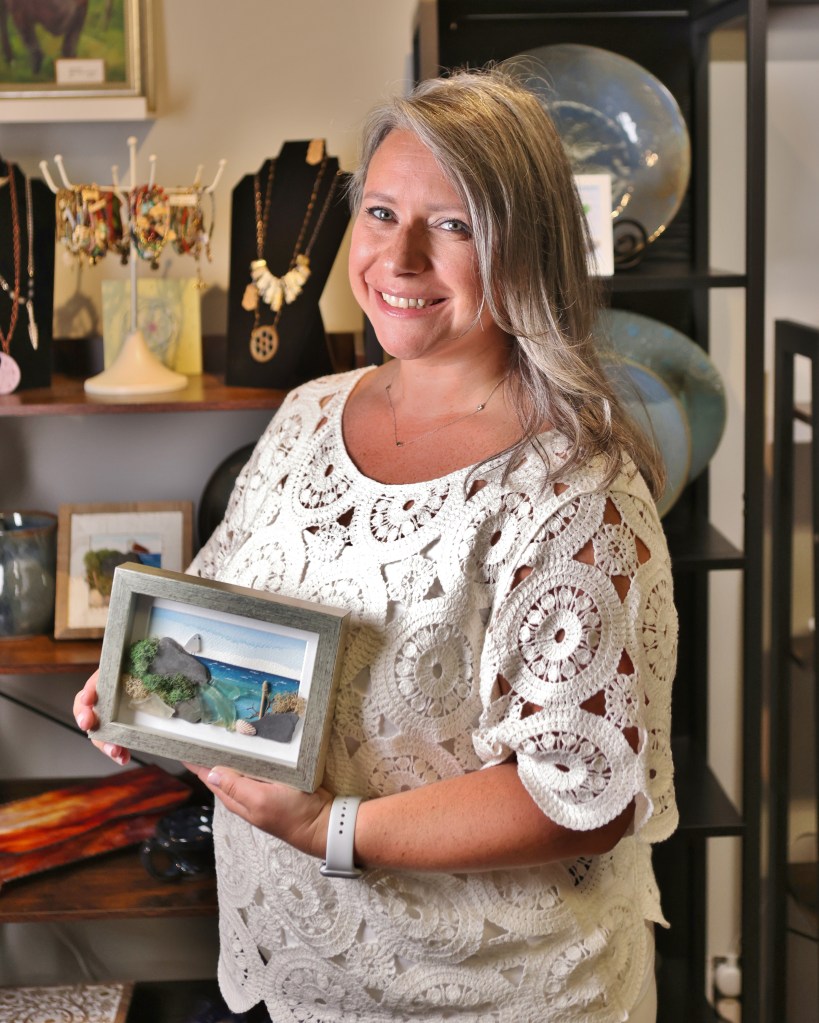
Di Rico advises others to stay true to themselves and the type of work they enjoy producing. “I found that creating things that I loved and in my way was the most successful,” she says. Quieting the outside noise is essential according to her. “It’s good to listen to feedback, but definitely be unique to your own creativity and try to harness that,” she adds.
“People were trying to throw me off track. But I had a vision, and I wanted to stay true to that vision and to focus on that.” She also says that it can be easy to get caught up in the demands of life, between having work, a family and responsibilities, so it’s important to find something that helps keep you grounded in times of stress.
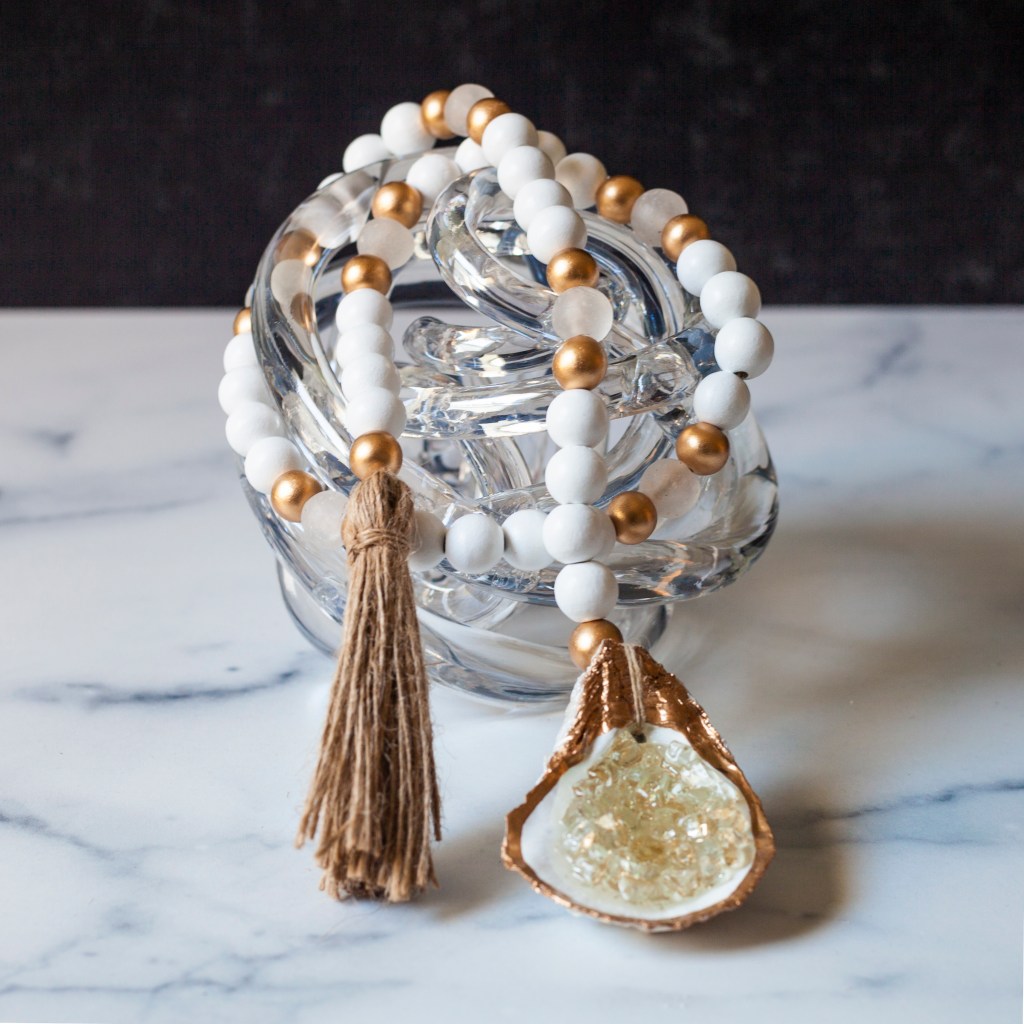
“I feel like everyone needs to find that thing that makes them feel grounded, that they can go back to and feel purpose.”
For her, that thing was Sea Schleps, and it continues to ground her day in and day out.
This appeared in the August issue of Behind The Hedges Powered by the Long Island Press. Read the full digital edition here. For more Master Craftsman columns, click here.


